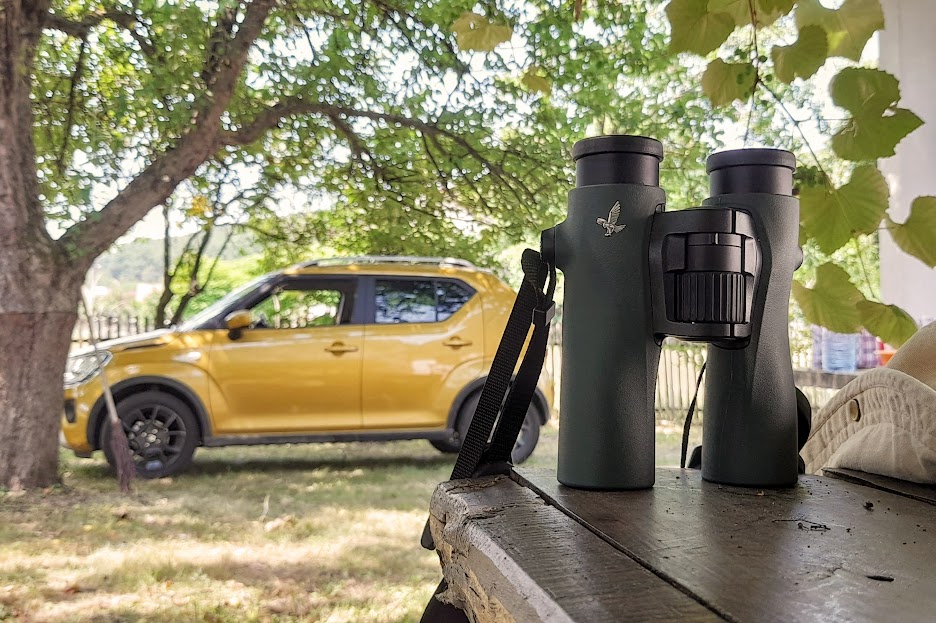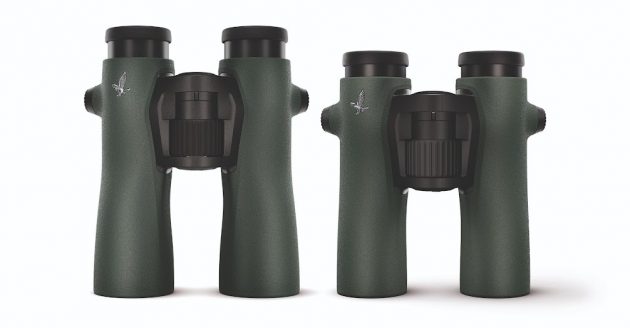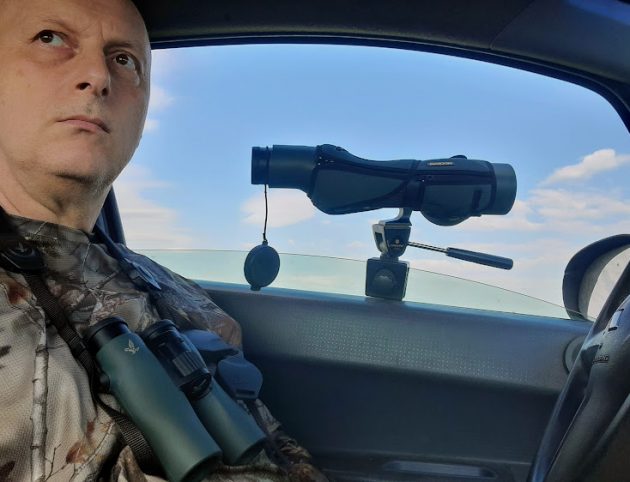
After testing both Swarovski NL Pure 10×42 and 12×42, I – a self-confessed lover of smallish full-size binoculars, felt the urge to try the latest 32 mm NLs. For most of my birding life, I birded with 8s, and with NLs and their extreme wide-angle field of view I found myself in a dilemma: should I stick to 8s and gain a 20% wider FOV, or should I keep the FOV I am used to and am happy with, but gain some extra magnification?
 NL Pure 42 mm vs. 32 mm
NL Pure 42 mm vs. 32 mm
Ideally, I would love to have both, but binoculars are a lot like kayaks: if you want to go faster, go for a straighter, slimmer and longer hull. Yet, if you want more control in tight bends, go for a shorter, curvier and wider boat. You cannot get both short and long hull in a single kayak. Choose what is more important to you and sacrifice the other. It’s the same with binoculars: I can either get a wider FOV with a true wow-effect, or a higher magnification while keeping the same FOV I am already using. What should it be?
Most of the time I bird my local patch, consisting of mosaic habitats with a series of ponds intersected with islets of willows and poplars and surrounded by grasslands and forests. Usually I am not in completely open habitats, and even less often inside a closed-canopy forest. If I were a forest birder, without a second thought I’d go for 8s and their extra FOV, yet this way I felt that my FOV is satisfactory, hence I opted for a higher magnification: 10×32 NLs.
The very first time I held them, the very first look through them, I just knew: this is it, this is the pair for me. Full stop. Although I did test them thoroughly later, I knew from that first sight, this pair was made for me. The old knight in that Indiana Jones cave full of holy grails to choose from would say to me: You have chosen wisely.
What made me so certain, so quickly, so easily? When I picked them up, I used the last hour of the day at the nearest pond to try them on Whiskered Terns and Squacco Herons, European Bee-eaters and a Black Woodpecker, Eurasian Golden Orioles and Great Reed Warblers. Expectedly, the views were bright and crisp, focused edge to edge.
10s are a whole new experience compared to 8s. It is a new level of quality birding, giving me just that bit of extra magnification I needed for a long time. I still carry my scope with me most of the time, but with 10s I do not reach for it as much as I did with 8s.
32 mm NLs are 144 mm/5.7″ long and weigh rather a moderate 640 g/22.5 oz, hence they can be easily worn around the neck for the whole day without fatigue. The barrels are flattened into ellipse in the middle section, making NLs noticeably slim and ergonomic to hold. The FOV of 10×32 is 132 m/1000m (396-foot/1000 yards), while the light transmission is 92 %. I am not a very technical person and I do not feel like going into fine numbers and percentages much more. Of course they are waterproof and inert gas filled, that is already becoming a standard in mid-range binoculars, and NLs are as premium as can be.
After ages spent with bins around my neck, I knew exactly what it was that I needed, that I liked, that I wanted. NL 10×32 are comfortable to use, they fit my expectations perfectly and they are everything I ever dreamed of in a pair of binoculars: seductively bright and crisp, moderately sized and almost lightweight.

Still, if I like everything, is there something I do not like? There is, once you adjust the dioptre, you cannot block it in the position. Some people commented that the spike on the front side, next to the focusing wheel, used to adjust the dioptre, is hard to move anyway, but I find it not true. You are unlikely to move it when binoculars are hanging from your neck, but when driving alone, I tend to keep the binoculars in the passenger seat, front side down, as I have been doing for decades. And that spike is on the front side and it is quite prone to movement during the drive. Now I am trying to put the front side up, but I do find it odd to have to twist my hand before I put them down.
NL Pure 10×32 is actually the 6th pair of Swarovski binoculars that I have tested. I was happy with CL Companion 8×30, so much so that I used them for 11 years without deciding to upgrade to ELs. But the extra-wide FOV of NLs is a true game changer, making 10s the new 8s.
Now I could give an elaborate conclusion why the NLs are so good, but would you really want to read that? They are so good that I put my money where my mouth is and bought them. And that is my conclusion: I don’t think I will ever be looking for a new pair of binoculars.













I just had to share this Facebook comment by Tom Casey: “Outstanding reviews! I have enjoyed them all! Concise information, and excellently communicated feel and impressions!
Thank you Dragan Simic!”
How is the low light performance against a 10×42 in your experience?
I am considering these binos and its my only concern
Regards
Hein Bester.
I tested those two with one year in between and am not able to compare the finer points now, but am very happy with my 10x32s.
32s are great in low light, but is there a noticeable difference, I can no longer say.
Thank you for the reply. It helps a lot.
Curious to know how “fast” it will focus – precisely how many turns of the focus wheel are required to go from close focus to infinity? You can mark the near end of the focal wheel with chalk, then physically measure the number of turns.
It’s probably personal druthers but I’ve compared focal speeds in the field and while using faster speed definitely see more individual birds well while birding in those areas offering short viewing times – usually birds briefly flitting through small foliage windows at varying (near to far) distances.
Just curious. Please respond to my e-mail address. TY! Nice reviews, btw. df
Ahh, just found it. “The focus wheel, for example, is further forward than you expect, but at just over a finger wide and heavily textured, it’s easy to find and grip even with gloves on. It moves very smoothly and moderately stiffly, taking exactly two clockwise turns from close focus to infinity.”
Hi Dave,
I already have an excellent NL Pure 8×42. (And 8×25 VP) . I live in a forest area.
I am thinking about adding an 10×32 for moren open lands.
Do you think its worth it? Or is 10 x too close to 8 power?
Sander
Hey Dave,
Your opinion on the Swarovski 10×32 to take on beach trips and watching football and baseball games. Superior to say than the 8×32?
To Sandder: Sorry, I saw your comment only now. But regarding the stronger magnification for open habitats, I would go for 12s, or even 14s! I wish I could own more pairs of Swaros…